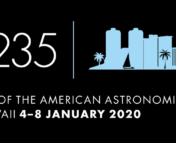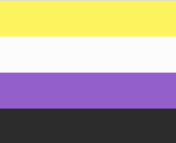By Briley Lewis
This Bite is part of Astrobites’ ongoing efforts to celebrate all cultures and identities in astronomy—specifically, we’re highlighting disabled astronomers and those fighting for disability justice in the field this month for Disability Pride Month!
Around one in four adults in the United States has a disability, whereas 10% of undergraduates and only 1% of doctoral students pursuing STEM degrees have a disability. Disability is a tricky thing though — it’s an identity that some do not see pride in due to stigma, and an identity that, when revealed, can result in significant discrimination. As a result, many choose not to reveal their disability status at all. Disability Pride Month is an effort to counter this stigma, instead reveling in the diversity of experience and vibrant community that disabled people create with their presence.
“Having pride in disability means this joyfulness — aligning your inner and outer selves and having some space to just be judgment free, just exist, just be and be okay with that,” says Alicia Aarnio, Assistant Professor of Physics and Astronomy at University of North Carolina, Greensboro. “The event [of Disability Pride Month] is sort of a community celebration of this joy, and it removes the isolation that all of that stigma imposes on people.”
Professor Alicia Aarnio is a vocal advocate for disability justice, founding member of the AAS Working Group on Accessibility and Disability (WGAD), and a disabled scientist herself. In today’s interview, we discuss the conflicting joy and rage of navigating astronomy (and the world) with a disability, as well as her science work, which is literally stellar.
Aarnio’s Career and Research
Aarnio had a fairly standard path into astronomy. She completed her undergraduate studies at a small liberal arts college, Smith College, which allowed her to explore varied interests — music, Spanish, chemistry — before moving on to do her PhD in Physics at Vanderbilt University. After multiple years of postdoctoral research at University of Michigan and University of Colorado Boulder, she became a professor at University of North Carolina, Greensboro.
Her work started with x-ray observations of the Sun, and looking at young stellar objects in moving groups, associations of stars that were born together and have similar velocities as they move through the Milky Way. Then, in graduate school, she expanded her focus to think about young stars with protoplanetary disks, and how the stars themselves are influencing the disks around them and any planets that may be forming.
Right now, she has multiple research projects going on, trying to understand the complex relationship between a disk and its star during planet formation. In one, she’s trying to understand a type of young stars known as Herbig Ae stars, and why they don’t have strong magnetic fields like older stars. You’d think that any spinning ball of plasma would naturally have a magnetic field — so what’s up with these weird little guys? Turns out, it may be related to how we observe magnetic fields with spectropolarimetry. We can easily resolve the magnetic dipole moments that older stars have, but we don’t quite have the resolution to see higher order moments. So there may be a magnetic field after all, and we just can’t quite see it yet!
Along with one of her students, Aarnio is working on another project about chemistry in protoplanetary disks, using radiative transfer models to look at disk chemistry around different types of stars. Often, people assume that higher mass stars are just like brighter Sun-like stars — but in fact, they emit more high-energy radiation, which could change the disk chemistry and make some molecules dissociate, or break apart. If the chemistry in the disk is different, the resulting planets could be different, too.
AAS WGAD
Outside of her science work, Aarnio is an active member of AAS WGAD, and has been since its creation circa 2015. Inspired by conversations at the 2015 Inclusive Astronomy meeting, Aarnio and colleagues petitioned the AAS to form the working group. Importantly, they also petitioned to allow junior members of the society to be part of the working group — something that previously wasn’t allowed. “Because of the way that disabled folks get pushed out of astronomy, our group skewed young. We had a lot of undergraduates and graduate students in the room,” recalls Aarnio.
WGAD has a Coordinating Committee, which Aarnio serves on, that acts as a liaison between AAS and the working group members. It’s truly a community-driven, collaborative effort. Aarnio explains, “our argument is, if you have a crowd of people, and five people at a time have enough spoons to actually do something, then we need as many people as we possibly can get to try to source the work.”
Since its founding, WGAD has made recommendations to make AAS more accessible. Aarnio is particularly proud of their work with journals and AAS publications, such as encouraging requirements for descriptive text on paper figures and guidance on how to make images colorblindness-friendly. Each year, they write an annual report for AAS, and are currently working on recommendations for how to make AAS meetings more accessible. They’re also trying to learn more about the disabilities within our community, in order to better advocate for the people who live with them — previously, AAS demographic surveys only asked if participants had visual, hearing, or mobility impairments. This quite obviously doesn’t encompass the wide spectrum of disability, so WGAD has advocated to add more options to the questions related to disability. Unsurprisingly, when the definition of disability is expanded (as it should be), more astronomers identified as disabled.
Aarnio also led a white paper on accessibility for Astro2020 (we wrote an Astrobite about it!), which many WGAD members were involved in. It provided recommendations in three categories: what departments can do, what professional societies like the AAS can do, and what funding agencies can do. Notably, this was the only white paper submitted for Astro2020 that directly focused on accessibility and disability, although there were many others that focused on other aspects of inclusion and marginalized identities. Despite the importance of accessibility for truly equitable DEI efforts, disability was only briefly mentioned in the Decadal Survey final report — a disappointing outcome for many disability advocates in the field, the author of this bite included.
The Meaning of Disability Pride
“Disability as an identity is so hard for a lot of people to accept for themselves, and then to also be comfortable with anyone else knowing about,” says Aarnio. “To me, [disability] pride means rejecting this stigma, because the stigma will have you believe that you aren’t worthy, that you shouldn’t have any self worth, that you don’t have any inherent value.”
Aarnio continues, “Pride brings along with it this tension, because if you fully exist in yourself as you are and honor yourself as you are, you start encountering these systems and structures that don’t value you. And there’s this, like anger, grief, and dissonance that arises from that particular interface, which makes it hard to maintain pride. Another piece of tension is the privacy of your own situation that you want to maintain. But there’s also this sort of demand, like people want to know, they want to see people living out loud…So to me, pride means having to carry a lot of things simultaneously.”
This year, Disability Pride takes on another conflicting undertone, with the pandemic raging on with little regard for public health — and the lives of disabled and high-risk people. “We can’t have the kinds of Pride events that you might see for non-disabled members of the LGBTQ community, because we can’t go out there,” Aarnio explains. “People at risk have to stay home, we can be proud at home…but I’m seeing all these conferences, and I’m bubbling about it, because it’s like my employer and these organizations and my colleagues don’t give a shit about my life. They don’t care if I live or die. And it’s so hard to juxtapose pride with that.”
Despite these challenges, Aarnio stresses the critical importance of community, advising disabled scientists to find networks of mutual support to rely on during their careers (plus a good therapist). She explained that discussions and connections with other disabled scientists can help people, such as herself, discover and embrace their identities as disabled scientists and create spaces where disabled scientists can be their full selves. “To see other people who are also disabled scientists and total badasses in their own right, has been just wonderful,” she says. “I’ve met so many astronomers with disabilities who are now my friends, and it’s really cool. They’ve helped me figure out what I need when I’m struggling to identify that myself.”
If disability justice activism is something that you want to get involved in, anyone is welcome to join the AAS WGAD. Aarnio also shared a list of disability advocates and relevant Twitter hashtags that may be useful.
The current state of accessibility in astronomy may leave much to be desired, but the work of scientists like Aarnio proves that there is a future where disabled astronomers can thrive. It’s up to our community to make that future happen.
Astrobite edited by: Luna Zagorac
Featured image credit: AAS WGAD




